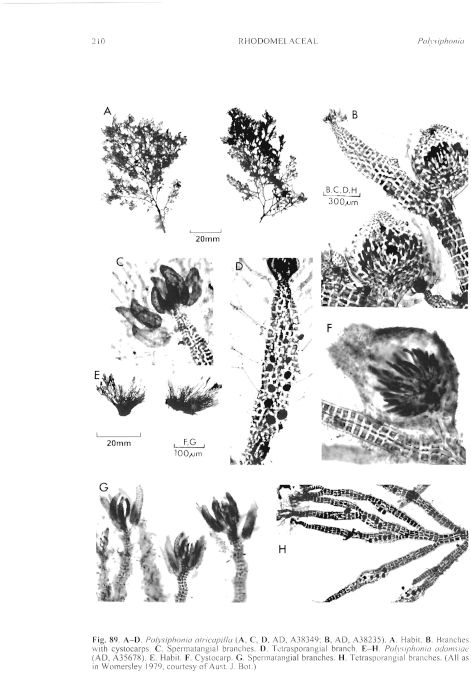|
|
|
|
|
|||||||||||
|
Electronic Flora of South Australia Species Fact Sheet
Phylum Rhodophyta – Family Rhodomelaceae – Tribe Polysiphonieae
Selected citations: Adams 1994: 325, pl. 110, centre left.
Thallus (Fig. 89E) dark brown-red, 0.5–3 cm high, usually forming dense mats on low intertidal rock, with densely entangled prostrate filaments producing numerous erect axes bearing simple to branched, fastigiate, laterals, often denser near the apices and denuded below, and often densely covered with microscopic epiphytes. Attachment by rhizoids from prostrate filaments; epilithic, occasionally epiphytic. Structure. Prostrate filaments densely entangled, 100–140 µm in diameter with segments L/D 0.5–1, with prominent apical cells, few trichoblasts and attached by unicellular rhizoids not cut off from the pericentral cells; erect axes 100–200 µm in diameter with segments L/D 0.5–1.5, and branchlets 60–100 µm in diameter with segments L/D 0.2–0.8; apices straight, with slender trichoblasts, soon lost; lateral branches arising in place of trichoblasts every few segments, with occasional cicatrigenous branches below. Pericentral cells 10–11 (–12), elongate except close to apices, ecorticate; trichoblasts from every segment near apices and scar cells usually present and prominent near apices, with a divergence of 1/7–1/10, often absent from lower segments; trichoblasts slender (basal cells 20–30 µm in diameter), 1–3 times furcate. Rhodoplasts discoid, scattered.
Reproduction: Gametophytes dioecious. Carposporophytes with a small basal fusion cell and short gonimoblast bearing elongate-clavate terminal carposporangia 15–25 µm in diameter. Cystocarps (Fig. 89F) short-stalked, ovoid-urceolate, with sometimes enlarged or often subdivided ostiolar cells, 280–450 µm in diameter; pericarp ostiolate, 2 cells thick, outer cells isodiametric, angular. Spermatangial branches (Fig. 89G) replacing the whole trichoblast, cylindrical and slightly tapering, 120–200 µm long and 25–50 µm in diameter, usually without sterile apical cells when mature.
Tetrasporangia (Fig. 89H) forming gently spiral series in upper branches which are often slightly curved with the sporangia towards the outside, with a divergence of about 1/9, often extending below a branch, only slightly swelling the segments and occupying 0.5–0.7 of the segment diameter when mature, subspherical, 30–50 (–60) µm in diameter.
Type from Orford, Prosser Bay, Tas. 0–3 m deep (Shepherd, 10.ii.1970); holotype in AD, A35678).
Selected specimens: Stingray Bay, Port Arthur, Tas., lower eulittoral (Cribb 160.23, 16.xi.1951; AD, A21047). Safety Cove, Port Arthur, Tas., lower eulittoral on Cystophora torulosa (Skinner, 21.ii.1978; AD, A49255). Bicheno, Tas., lower eulittoral (Womersley, 4.xi.1982; AD, A56457). Fortescue Bay, Tasman Pen., Tas., uppermost sublittoral (Womersley, 22.x.1994; AD, A64210). Lady Bay, Southport, Tas., lower eulittoral (Womersley, 28.x.1982; AD, A56542).
Distribution: SE Tasmania. South I., New Zealand.
Taxonomic notes: P. adamsiae is similar in form to P. isogona (see below) but is distinguished by the number of pericentral cells (most commonly 11), the rhizoids not being cut off from the pericentral cells and the spermatangial branches replacing the whole trichoblast.
References:
ADAMS, N.M. (1994). Seaweeds of New Zealand. (Cant. Univ. Press: Christchurch.)
WOMERSLEY, H.B.S. (1979). Southern Australian species of Polysiphonia Greville (Rhodophyta). Aust. J. Bot. 27, 459–528.
The Marine Benthic Flora of Southern Australia Part IIID complete list of references.
Publication:
Womersley, H.B.S. (24 February, 2003)
The Marine Benthic Flora of Southern Australia
Rhodophyta. Part IIID. Ceramiales – Delesseriaceae, Sarcomeniaceae, Rhodomelaceae
Reproduced with permission from The Marine Benthic Flora of Southern Australia Part IIID 2003, by H.B.S. Womersley. Australian Biological Resources Study, Canberra. Copyright Commonwealth of Australia.
Illustration in Womersley Part IIIA, 2003: FIG. 89 E–H.

Figure 89 enlarge
Fig. 89. A–D. Polysiphonia atricapilla (A, C, D, AD, A38349; B, AD, A38235). A. Habit. B. Branches with cystocarps. C. Spermatangial branches. D. Tetrasporangial branch. E–H. Polysiphonia adamsiae (AD, A35678). E. Habit. F. Cystocarp. G. Spermatangial branches. H. Tetrasporangial branches. (All as in Womersley 1979, courtesy of Aust. J. Bot.)

|
Email Contact: State Herbarium of South Australia |

|